- This article tells what does Tibetan flag say, significance of stacked stones, Dharma Chakra with deers and why monasteries painted in bright colours. And about Tibetan food.
In the land of lama, don’t be a gamma. A sage advice given by those that build and maintain roads in these cold, barren lands. Whoever has travelled to the distant high mountains of Ladakh and Spiti have seen these cautionary yellow boards with advice written in black by the BRO, asking drivers to be careful.
While being a ‘gamma’ on these rough roads would ensure that the ‘gamma driver’ receives a quick free ride to the land of the dead, the ‘Lama-Land’ by itself is a beautiful and colourful one, with majestic natural landscapes.
Here one cannot miss the innumerable
pretty chortens that dot the landscape; and gaily fluttering flags with their
printed mantras that brighten up houses, farms, mountain passes, and water
bodies.
I had once asked a Ladakhi about the
flags, and was told how the symbolic flags carry powerful mantras that spread
far and wide with the winds, warding off evil. As I stood beside the blue
waters of the Pangong tso listening to him talk on Buddhist philosophies, I
decided to dig deeper once back home and find out more on Tibetan cultural
practices.
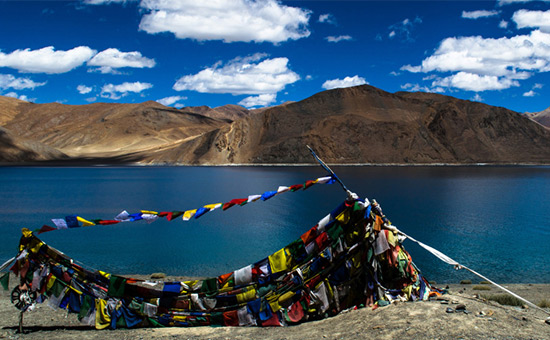 Colourful Tibetan flags around Pangong Lake.
Colourful Tibetan flags around Pangong Lake.
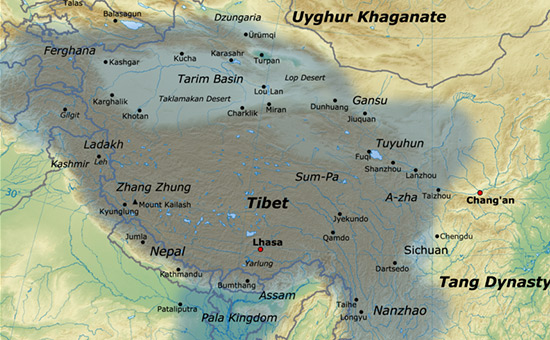 Map shows Tibetan Empire.
Map shows Tibetan Empire.
Full caption The mighty
Tibetan empire in the 8th c. CE. Parts of what we now know as Ladakh, Spiti,
North Bengal, Sikkim, and Arunachal Pradesh, were under their control. Hence,
it is not surprising that we find nuances of the Tibetan culture still
running strong in many of these parts. While now, geographically and
politically, Tibetans refer to those from Tibet, culturally many Indians also
practice the Tibetan customs, which is pretty obvious when we travel to the
Himalayan states. Here I will be referring to these common customs as Tibetan
customs, which will include people from Ladakh, Spiti, and other Himalayan states in India. (Photo courtesy: Wikipedia)
What do the flags say?
Hanging long strings of prayer flags/banners, and
hoisting prayer flags on poles is a unique characteristic of Tibetan culture.
These flags are seen almost everywhere in the Himalaya, and each time you see
them, you know Tibetans live somewhere nearby. The gaily coloured flags and
banners are seen fluttering on mountain passes, mountain tops, farms, forests,
beside water-bodies, houses, gompas, and beside roadside chortens and stupas.
In Tibetan language these flags are referred to as dar lcog, wherein dar means cotton
cloth and lcog means an upright position;
thus denoting a cotton cloth put straight up (besides cotton, silk and silk
like synthetic fabrics are also used). This custom has been in practice for
more than a thousand years now, and it is believed that initially the
tradition started as a symbol of war, which later modified itself to denote
religious activities.
As Buddhism took hold among the Tibetans, the
ancient war symbols (flags and spears) slowly turned into philosophical symbols
of positive energy that brought forth good fortune, while removing obstacles
and unhappiness.
A closer look at the flags and
banners show us that there are some fixed colours used here. Five different colours are always used in the same
order: blue on top, followed by white, red, green, and yellow.
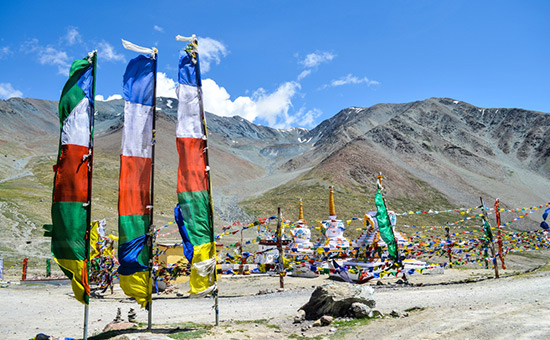 The five colours in their proper sequence at
Kunzum la Pass Himachal.
The five colours in their proper sequence at
Kunzum la Pass Himachal.
The five colours used denote
five natural elements that are seen around us. Blue denotes the sky,
white stands for clouds, red is for fire, green is for water and yellow depicts
the earth.
The Tibetan belief is that there must be a balance between these five external natural elements for
prosperity (good crop yield and thriving cattle) and long lives of
people, which in turn will fill the world with happiness and peace. When the
balance is lost, unhappiness and misery will engulf the world.
However, there is another line of Tibetan philosophy that claims the colours represent water (blue), iron (white), fire (red), wood (green), and earth (yellow). In this case the colours should be placed giving precedence to the raiser’s dominating natural element. So if your natural element is water, the blue prayer flag should flutter more abundantly in your house, garden, or farm.
Prayer flags are most often seen with mantras, verses, and different figures printed on them. The most common is the “windhorse” prayer flag that is a symbol of victory. The flag bears a horse (known as klung rta) in the centre and a snow lion, tiger, a dragon, and a garuda in four corners. The flag carries the mantra, “May the horse of good fortune run fast and increase the power of
life, influence, fortune, wealth, health, and so forth.” According to the Tibetan philosophy tiger is the head of all carnivores, snow lion the head of herbivores, garuda the head of bird kingdom, and dragon rules the sky; therefore these are four supreme animals with supreme power to defeat all. The horse at centre represents a journey from evil to goodness, and signifies a positive energy and fulfilment of desires. The name “windhorse” is a recent one(rlung rta is written now instead of the original klung
rta) , and is likely derived from the fact that these flags
are raised high on poles and keep fluttering in the wind.
 The “windhorse” flag. The running horse is at the centre and the four supreme animals at each corner. Photo from Wikipedia.
The “windhorse” flag. The running horse is at the centre and the four supreme animals at each corner. Photo from Wikipedia.
 Stacked stones.
Stacked stones.
The stacked
stones tell a story too
The stacked stones, which is common
across the land of the lama, tell us tales of previous travellers who have been
to that place. Often stacked stones that are seen on mountain passes are
covered with prayer flags. These cairns are revered objects, as it is believed
they help to please the natural spirits/deities.
These stacked stones/cairns with the prayer flags
are known as la btsas. Here the
word la means mountain pass, and btsas likely refer to a
tax paid when going to a sacred place.
The practice supposedly started long back, when
travellers and traders in the ancient times made arduous journeys across high
altitude passes. Once a pass was reached after a trek that was fraught with
dangers at every step, it was considered a major achievement.
The travellers would then collect stones, make a
stack, and place some food item on it as an offering (this was the tax paid for
partly accomplishing a dangerous job). Besides serving as offerings to create
positive energy, the stacked stones with food items were also offerings for the
later travellers who might arrive exhausted and without any food.
With the passage of time as travelling turned less
arduous, this practice of boosting the morale of later travellers by keeping
food for them gradually went obsolete, and stone stacking turned into a custom of appeasing gods. As more and more stones
piled up, flags were put on them, and slowly they turned into means of
pacifying the natural spirits and gods.
There is another line of thought which
believes that in ancient times the mountain passes were boundaries of different
kingdoms, and as people crossed the borders they were obliged to pay taxes,
which later changed into a custom of appeasing deities.
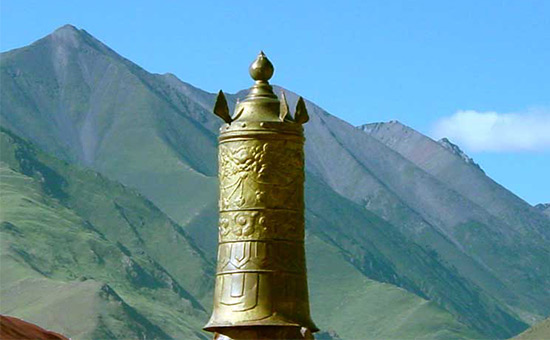 Dhvaja or victory
banner, on the roof of Sanga Monastery in Lhasa. Photo from Wikipedia
Dhvaja or victory
banner, on the roof of Sanga Monastery in Lhasa. Photo from Wikipedia
The Victory Banner that speaks of defeating four demons
A victory
banner is also found on the roof of Ki monastery in Spiti (Himachal).
The Victory Banner or the dhwaja (in
Tibetan it is known as rygyal mtshan)
is seen on top four corners of shrines,
gompas, and palaces, and are generally made of gold, beaten copper, bronze, or
silk.
The banner signifies Buddha’s victory over the four enemies or Maras (four demons signifying
aggregates, destructive emotions, death, and our desire for pleasure).
Traditionally, the victory banner is a cylindrical
structure mounted upon a wooden pole with silk valances. At the top is a small
white chhatra that is surrounded
by a wish-fulfilling gem. The chhatra is often bordered by makara heads,
and white or yellow scarves are hung from these heads. In the upper part, the
victory banner may show three or nine silk valances denoting protector deity.
Three valances reflect Vaiśravaṇa, who protects the northern parts; while
nine valances
depict the nine auspicious signs.
The victory banners have figures of mythical animals (yalis) that show eagle with the body of a lion, or the head of a fish on an otter’s body. Sometimes a victory banner may have a trident surmounted on black silk, as seen
on the roof of the Potala Palace (photo on side, courtesy Wiki).
 The Golden
Pinnacle.
The Golden
Pinnacle.
The Golden
Pinnacle is actually the Buddha!
The Golden Pinnacle (gan ji ra) as the name suggests is always in
gold or bronze, and is placed on top of
palaces, temples, and gompas. There are five parts, one on top of the other,
and each symbolises Buddha in different forms.
The lowest is a lotus which depicts Amitabha (of
infinite form; The Buddha of Immeasurable Light and Life); over it is
a bell that represents Amogasiddhi (the one that
destroys evil and always protects); next is a wheel symbolising Vairocana (of
the Universe, representing emptiness); fourth is
a vase depicting Akshobhya, the immovable one who
possesses mirror like wisdom and a consciousness of reality that can purify any
negative emotions, like anger; and the last one is
a jewel depicting Ratnasambhava (born of the jewel),
who removes pride and bestows the wisdom of equality.
The Dharma
Chakra with a Deer and a Stag
This is a common sight on the roofs of all
monasteries: the wheel with two deer (one male and one female). It is a
symbolic depiction of attraction of all beings towards the Buddhadhamma.
The wheel represents the Three Higher Training of Buddha, which is the
only supreme path for all to tread. The rim of the wheel is the Buddha
Sutra; the 8 spokes represent Abhidhamma
and knowledge; and the central hub is Vinaya.
The 8
spokes also represent the Noble Eightfold Path and teachings of the
Buddha, while the two deer symbolise knowledge and means to achieve
it. The Noble Eightfold Path is the way that leads to freedom from the
painful cycle of deaths and rebirths.
Do the
Pleated Awnings have any religious significance?
Though there are no recorded explanations, if we go
by what the elderly say, the pretty pleated awnings that we see on doors and
windows are auspicious, and bring in wealth and prosperity. These are
regularly changed during the Tibetan new year (losar), or during any
family weddings, and removed when someone dies in the family.
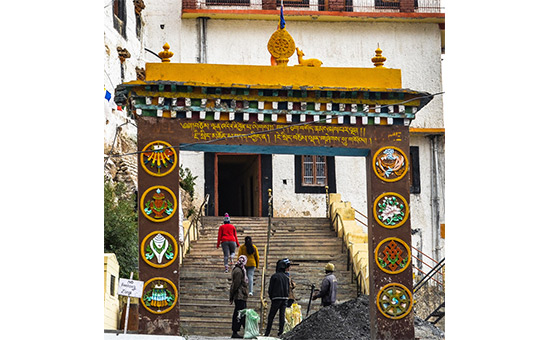 Seen
on the gateway to the Ki monastery are the eight auspicious signs.
Seen
on the gateway to the Ki monastery are the eight auspicious signs.
The Well
Known Eight Auspicious Signs
Starting from the left pillar down and moving up are:
1. Victory banner
which stands for victory over evil and overall protection
2. The white conch
symbolises beautiful melody of the Buddha dhamma
3. The vase
symbolises knowledge, merit, and fulfilment
4. The
umbrella/chattra/parasol removes the ill effects of ignorance
5. The two fishes
symbolise removal of all imperfections and ensuing prosperity
6. The lotus
symbolises the existence of a person amidst all worldly duties (samsara) but
being devoid of any worldly attachments
7. The endless knot
represents the five wisdom and infinite knowledge
8. The dharma chakra
represents the Three Higher Training.
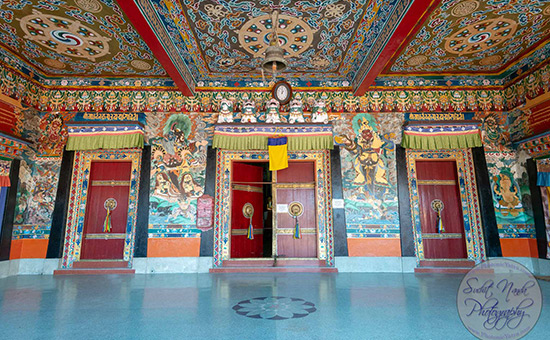 Monastery in Sikkim. Pic by Suchit Nanda.
Monastery in Sikkim. Pic by Suchit Nanda.
Have you ever wondered why the monastery walls are painted in such bright
colours?
Painting monastery walls in red, yellow, white, and
black is a unique ancient practice, and it symbolises the invoking of deities
associated with rage, control, prosperity, and peace.
The colours are also means of seeking protection of
Manjushri, Vajrapani, and Avalokiteswara, the three great protectors. Red
colour stands for control over the three realms; while white means keeping
diseases at bay and removing hindrances; yellow stands for a long and
prosperous life, and black symbolises removal of all enemies.
Interestingly, before Buddhism made an appearance
in these parts, Bon religion was the ancient religion of the Tibetans. The Bon
religion believed in the worship of natural spirits, and exorcism to
drive away the demons and remove negative effects. Many aspects of the Bon
traditions were absorbed into the Tibetan form of Buddhism, which took a
stronghold in these parts from 7th c. CE onward under the patronage of Tibetan
kings. The Bon religion still survives in some parts of Tibet, and the adherents
follow practices and philosophies that show a striking
similarity to Buddhism.
 Dressed salad.
Dressed salad.
Let’s end on a happy note: That’s a wholesome Tibetan meal!
While in land of the lama, eat like the lama. I
always enjoy tasting local cuisine wherever I travel, so the Tibetan local food
was more than welcome when offered. For breakfast I had roasted barley flour (tsampa) with milk and honey, and absolutely loved it. It’s a must try for all cereal lovers.
Culturally, roasted barley flour holds great
significance for the Tibetans, and is held with great reverence. Their most
auspicious dish is Butter Flour or phye
mar, where phye is ground barley and mar is
butter. Butter flour along with roasted wheat are served in two different bowls
as offerings to the deities.
The tradition of offering butter flour to deities goes long back in Tibetan history, and is traced back to periods earlier than 6th c. CE. It is connected with the ancient Bon religious practices, when the communities led a nomadic life and relied on their agricultural outputs for food. Roasted barley signifies the agricultural output, while butter is the essential product of all nomadic lives. The ancient Bon offerings still continue, showing the Tibetan community’s historical roots in agriculture and nomadic life.
For dinner we were served a series of rather delicious
fare:
Few words at the end….
The Tibetans inhabit a land that is barren and
extremely harsh to live in. Yet their cultural practices and traditions are
full of colours, almost as if to balance the bleakness of the landscape that
surrounds them.
The beauty of Tibetan traditions lie in the unique
combination of the ancient Bon religion and Buddhism, and the seamless
amalgamation that keeps both the religions alive and in perfect harmony.
The cultural practices that I have touched upon are the ones that we notice commonly while travelling, and is just the tip of the iceberg. Beyond the tip there’s a world out there of unique cultural practices and traditions that are as colourful and complex as one can imagine.
Tibetans are among the most peaceful
and kind communities that exist in the current scenario; yet such a unique and
colourful culture today faces the risk of losing their very identity and
perhaps even going extinct under various sociological pressures and challenges.
Therefore, it is now essential for
the people who travel to these places to start acknowledging the uniqueness of
this rather gentle and peace loving community, and to help them in maintaining
their distinct identity, without imposing anything external.
As we love the Himalaya more and explore it deeper, it’s also now our responsibility to respect and help preserve the uniqueness of each of community that inhabit the nooks and corners of these sacred mountains.
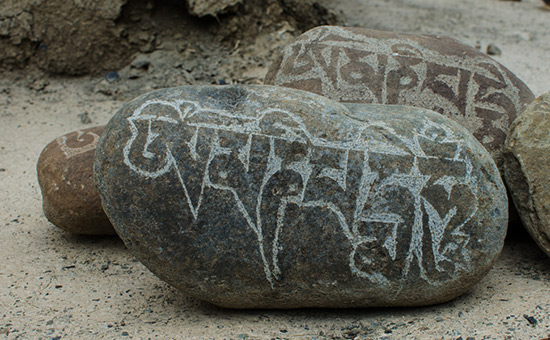 Lantsa script on Mani stones. It’s an Indian Buddhist script, likely of late Pala origin, hence Bengalis often find some alphabets similar.
Lantsa script on Mani stones. It’s an Indian Buddhist script, likely of late Pala origin, hence Bengalis often find some alphabets similar.
Some books that help to understand the
Tibetan culture better:
1. My Third Expedition to Tibet by Rahul Sankrityayan (Author), Sonam
Gyatso (Translator)
2. Tibet: An Inner journey by Matthieu Ricard (2012)
Sources of Tibetan Tradition by Schaeffer, Tuttle, and Kapstein (2013)
3. The Red Annals by Kunga Dorjee is a history book written in 1346 and discusses
the Bon traditions in details.
To read all articles by author
Author studies
life sciences, geography, art and international relationships. She loves
exploring and documenting Indic Heritage. Being a student of history she likes
to study the iconography behind various temple sculptures. She is a well-known columnist
- history and travel writer. Or read here
Article was first published on author’s blog and here
Article and pictures are courtesy and copyright author.